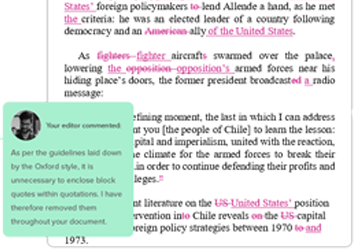Still have questions? Leave a comment

Checklist: Dissertation Proposal
Enter your email id to get the downloadable right in your inbox!

Examples: Edited Papers
Enter your email id to get the downloadable right in your inbox!
Need
Editing and
Proofreading Services?

Industry Insights: Proofreading Tips for a Business
 Jun 05, 2020
Jun 05, 2020 5
min read
5
min read
We’ve said time and again that everyone encounters writing in some form or the other. We are not referring to writing in the literary or even technical sense, but writing on a more functional level.
Communication through the written word is a crucial part of professional life, regardless of what field you work in. The language you use in your professional life can often be a representation of your work ethic itself, especially when you are speaking to external collaborators. There is the writing you do on an individual level – for instance, shoot an e-mail to HR about an upcoming holiday. And then, there’s the writing that is done on an official level. These may range from an internal report, a partnership pitch to another company, or the content you create for marketing. Either way, language matters.
Table of Contents
Tip 1: Create a style guide for your organization
Depending on the nature of your work, you can design your style guide to be simple – with minimal rules – or extensive – with elaborate rules. The point is that the style sheet should create a writing style that is distinct to your organization. Whenever you are communicating externally, you would be identified by this style.
What can you include in your style sheet? Rules about dialect, punctuation and capitalization, formatting, and the like. You can refer to this article to see how you can create a style sheet for your organization.
Tip 2: Set up a proofreading protocol
Once you have conventions in place, it’s all about implementing them. The real task is to make sure that these are being adhered to.
Set up a proofreading protocol that ensures that all communication – both internal and external – are written clearly. You can either appoint one person to the proofreading duty or multiple. The goal is to ensure that every document that represents your company is error-free and has clear messaging.
For instance, you can set up a buddy system that ensures that the same person who is writing does not end up proofreading as well.
Tip 3: The key is to be succinct
Sometimes, a draft is filled with long, run-on sentences that do not make sense. In business communication, it is important that your sentences are clear and straight to the point. Take a step back, and see (before checking for spelling and punctuation), if your sentences are structured properly. See if they make sense: in that, are they saying exactly what you want them to say?
Tip 4: Identify what type of errors you tend to make
If you are proofreading on your own, identify what kind of mistakes you tend to make most. Do you tend to misuse homonyms (similar-sounding words), or have jitters when it comes to commas? Once you identify them, you will find yourself more aware of what you’re doing and rectify these errors accordingly.
Tip 5: Don't rely solely on a spell-checker
Spellcheckers can be useful in making spelling and basic grammar corrections, but it is important to recognize that often it does not recognize context. (Pro tip: Don’t EVER keep automated spellcheck on your computer, just in case it makes unintentional changes.)
These are some of our tips to ensure that all your business communication is in order. Keep following PaperTrue for more editing and proofreading tips






